Foreword

This past year has undoubtedly been a year like no other – with the coronavirus (COVID-19) pandemic having a severe impact on our personal and professional lives.
The pandemic has not only had far-reaching social, economic and political impacts (some of which required intense and urgent action by the ECB), but also underlined the vulnerability of society to systemic shocks. The latter in particular highlighted the importance of also taking action to deal with climate change.
Over the past year we have had to completely rethink our way of working to achieve our institutional goals. This also led us to reflect on other lessons we can learn from the pandemic – and on opportunities to limit our environmental impact (such as less printing, less commuting and less business travel). In 2020 the ECB continued to reduce its carbon footprint and to enhance environmental protection with unwavering enthusiasm. I am therefore very proud that we again obtained validation under the European Eco-Management and Audit Scheme (EMAS).
For many years we have fostered collaboration with the environmental networks of other European institutions and national central banks to exchange ideas and best practices. These partnerships have proven to be especially valuable during a time filled with uncertainty and unforeseen challenges.
It is with great pleasure that I am able to say that we have established a climate change centre to strengthen the ECB’s climate agenda as of 2021. The new centre will coordinate the work on climate-related topics across the organisation and is a big step towards reaching our aim of becoming one of the world’s leading central banks in the fight against climate change. With this ambition in mind, the ECB has decided to align its environmental targets for 2030 with the Paris Agreement objective of limiting global warming to 1.5 degrees Celsius above pre-industrial levels. Over the coming months we will work on an action plan to achieve this goal. This entails improving the way in which the ECB calculates its emissions by further expanding our reported carbon footprint boundary. All this is crucial to make our impact along the value chain more visible and to drive positive change.
As you can see, we are increasingly embedding sustainability in our policy and operations and take a holistic approach to fostering sustainability at the ECB.
A lot has been done in the past year, but even more needs to be done in the coming years. I very much look forward to continuing our vital work together to enhance sustainability and environmental protection.
Michael Diemer
Chief Services Officer
1 Environmental management at the ECB
1.1 Organisational context

The outbreak of the global COVID-19 pandemic in 2020 has affected the ECB’s operations and everyday processes, particularly through travel bans and social distancing requirements. This led to a strongly reduced staff presence at all sites (the ECB’s main building, the Eurotower and the Japan Center) and to remote working across the entire organisation on an unprecedented scale. During much of 2020, working at the ECB’s premises was severely limited, with most staff working off-site since mid-March and the Japan Center being closed from the end of March until the beginning of August. Throughout the year, however, maintenance activities took place to ensure that the ECB’s buildings and their technical systems remained operational and continued to meet the required health and safety standards.
When evaluating the year’s environmental figures, the limited building occupancy needs to be taken into consideration, in particular when looking at lower consumption of energy, water and materials, as well as reduced waste generation. The ECB is also aware that some consumption was shifted from the ECB’s premises to the homes of ECB staff. Commuting and business travel emissions plummeted as meetings and work activities moved online. Consideration must also be given to indirect environmental impacts related to the increased use of information and communication technology.
Public debate in 2020 was also shaped by the launch of the European Green Deal, which promotes climate protection, biodiversity and circular economy concepts, and the expectations of a green recovery. Through its monetary policy strategy review, the ECB has been investigating where and how the issue of climate change and the fight against climate change have an impact on its policies (for more information, see Climate change and the ECB). At the same time, intense discussions took place across the bank on future ways of working and on how to contribute further to the fight against climate change by having more ambitious carbon reduction targets for the ECB’s own operations.
The organisational changes mentioned, including the related risks and opportunities and stakeholder expectations, will continue to serve as an important basis for the development of the ECB’s environmental management system and its objectives and measures.
1.2 Overview of the environmental management system and relevant changes

Environmental data for 2020 in the environmental statement relate to the three premises occupied by the ECB: the main building, which is owned by the ECB, and the Eurotower and the Japan Center, both of which are rented. Owing to gradually rising staff numbers in recent years, the ECB has occupied the entire office space of all three buildings since 2018. In 2020 the number of workplaces increased by 2.9% compared with the year before.
When assessing the environmental performance of the buildings, it should be borne in mind that they were built at different times and to different construction standards. Data for the main building are therefore reported separately from the aggregated data for the city centre buildings (the Eurotower and the Japan Center).
The ECB’s environmental management system (EMS) operates to the environmental reporting standards of the EU’s Eco-Management and Audit Scheme (EMAS), which has a three-year reporting cycle. This year’s environmental statement is the second update of the ECB environmental statement 2019.
The ECB’s environmental policy encapsulates the ECB’s commitment to environmental protection and gives direction to its environmental efforts. Further information on the ECB’s environmental policy and EMS governance can be found on the ECB’s website.
As part of its efforts to protect the environment and fight climate change, the ECB is working towards enhancing the environmental objectives and measures included in its environmental management programme. The ongoing work consists in aligning the ECB’s environmental objectives with leading international efforts to promote the efficient use of resources, foster biodiversity and limit global warming to 1.5 degrees Celsius compared to pre-industrial levels. In a first step, the ECB worked on expanding the scope of its reported carbon footprint to account for further indirect (Scope 3) emissions along the ECB’s value chain and continued to offset its reported residual greenhouse gas emissions in collaboration with the European Parliament and other European institutions.
2 The year in figures
Figure 1
2020 highlights
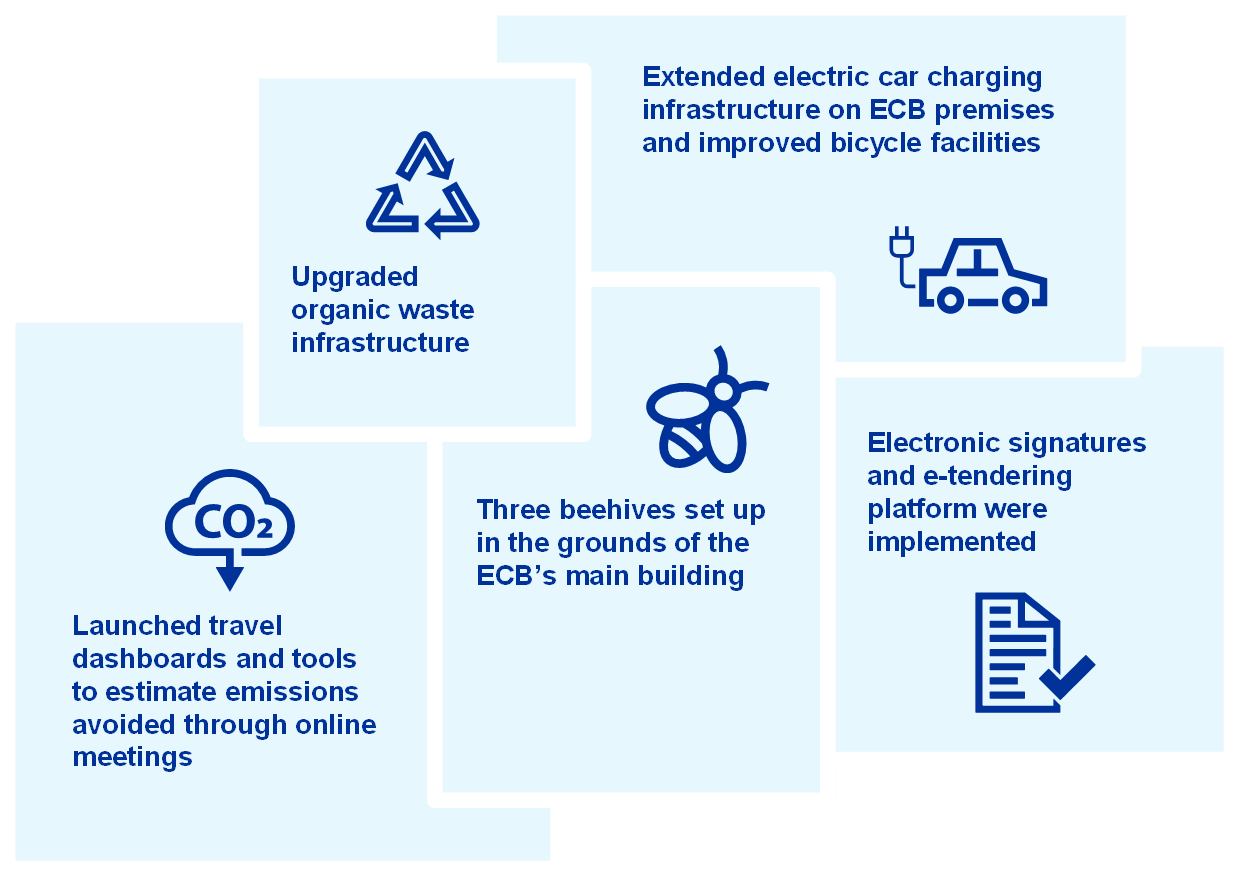
Source: ECB.
Figure 2
2020 in figures
(percentage change from 2019 to 2020)
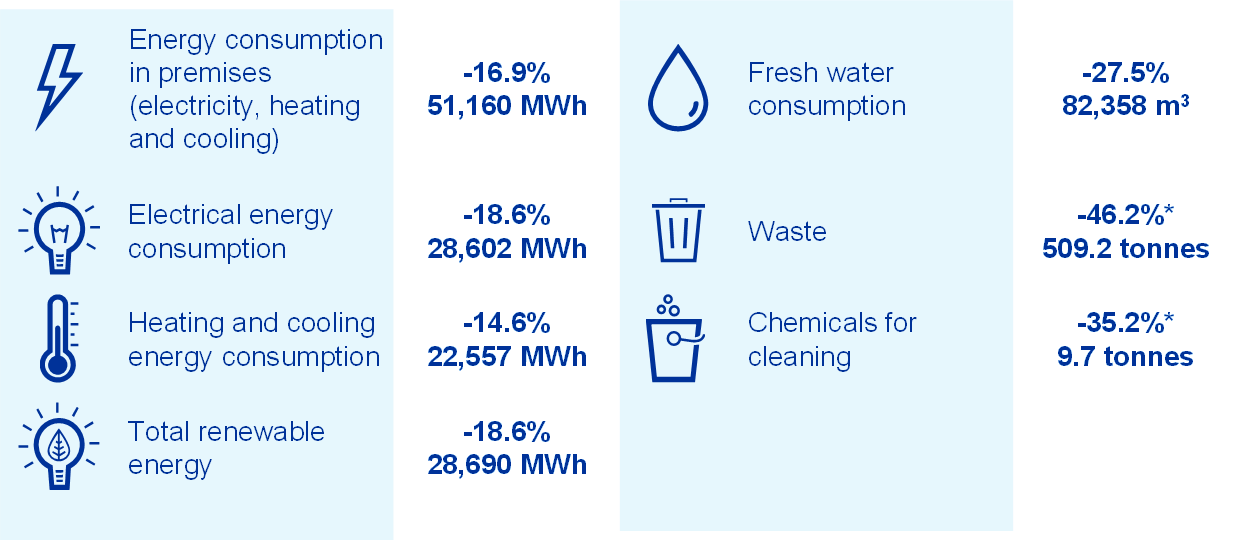
Source: ECB.
Notes: Environmental data per workplace in 2020 are included in Chapter 5 – Technical information, as they are considered less representative of the environmental performance in 2020.
* Owing to retrospective corrections of figures for cleaning agents and organic waste for the year 2019, the indicated decrease may not match previously reported values. The adjusted figures and further information can be found in Chapter 3.3.1.3 – Cleaning agents, Chapter 3.5 – Waste and recycling and Chapter 5 – Technical information.
Figure 3
Environmental figures related to the COVID-19 pandemic
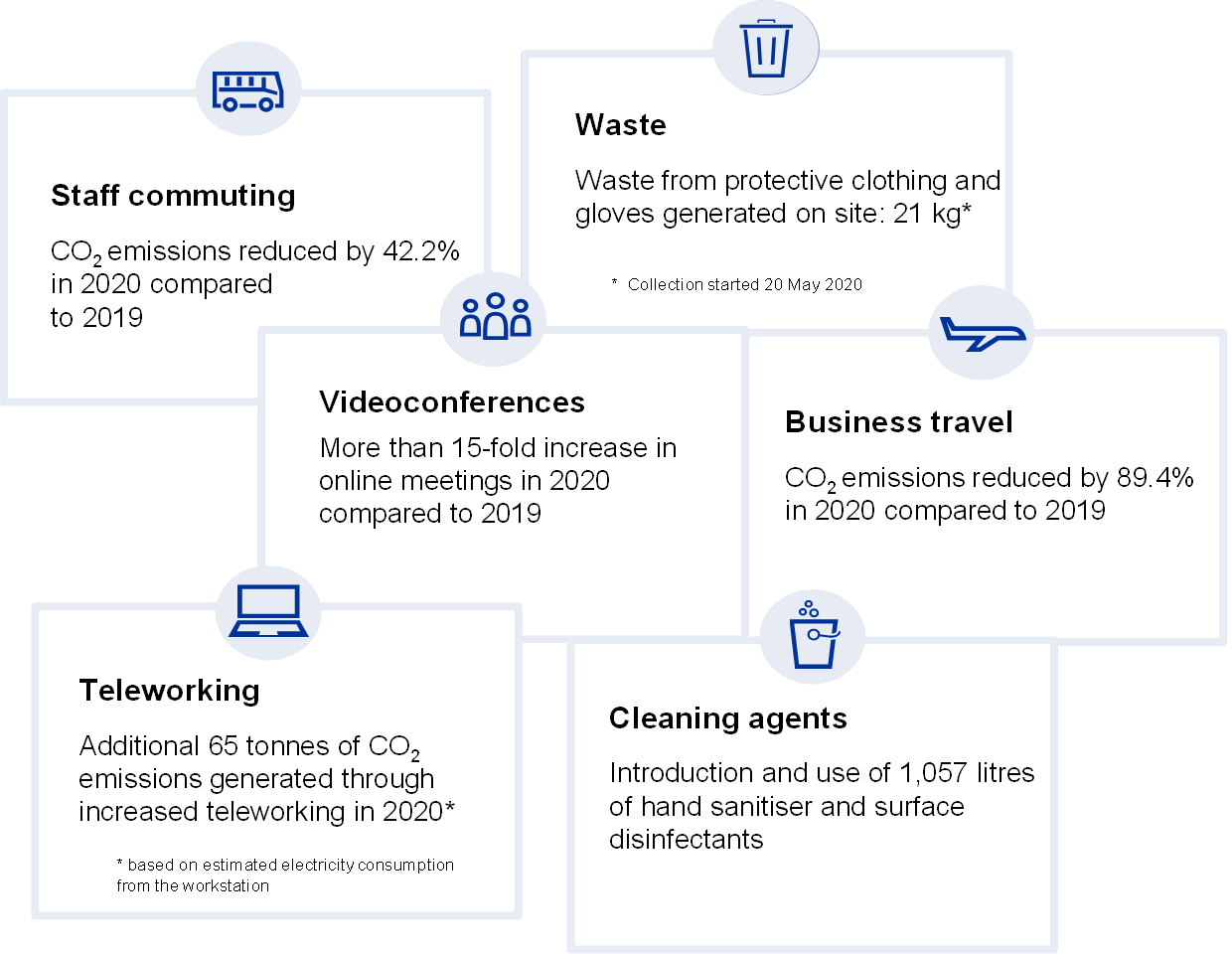
Source: ECB.
3 Environmental aspects and impact of the ECB’s activities
3.1 Update of the environmental aspects assessment
The ECB regularly assesses its environmental aspects against the following two criteria: the ability to influence them and their significance for the ECB’s environmental performance. The reduced consumption levels in 2020 show the impact of the limited on-site presence, while at the same time highlighting the basic consumption needed to keep the ECB’s premises in operation. Meanwhile, part of the consumption shifted to the homes of ECB staff, so the ECB is looking at ways to include teleworking as an indirect environmental aspect in the future.
Figure 4
Assessment of the ECB’s direct environmental aspects

Source: ECB.
Notes: Despite limited staff presence in the main building in 2020, technical equipment and processes, such as ventilation, needed to remain operational to meet hygiene requirements. This shifted the influenceability of electricity consumption in the main building to “medium”. Teleworking and the further digitalisation of work processes led to a reduction in paper consumption. Since most of the paper used at the ECB is recycled, the decrease in paper consumption also reduced the significance of recycled paper consumption across the bank. Strong reductions in non-hazardous waste owing to low building occupancy reduced the significance of waste at the ECB’s premises. However, this continues to be closely monitored as it partly shifted to the homes of ECB staff.
Figure 5
Assessment of the ECB’s indirect environmental aspects

Source: ECB.
Notes: Owing to travel bans in 2020, business travel emissions plummeted and were consequently of lower significance for the ECB’s environmental performance in 2020. The ECB nevertheless continues to closely monitor this environmental aspect and is assessing measures to sustain a reduction in business travel by air beyond the COVID-19 pandemic and its limiting effects on travel.
3.2 Energy efficiency




Note: Completed = measure completed; in progress = measure in progress; pending = measure still to be implemented.

In 2020 energy consumption in ECB premises decreased by 16.9% compared to 2019 owing to the low occupancy of all buildings. Various energy efficiency measures were implemented which supported this decline, such as further substituting lighting in the main building and the Japan Centre with LED lighting. In addition, the ECB continued its participation in an energy efficiency network with the aim of continuously identifying further energy saving potential. Nevertheless, it is recognised that some of the energy consumption shifted to the employees’ homes as the remote working regime lasted for most of the year.

In the main building, total electrical energy consumption has been gradually decreasing since 2015 owing to the continuous improvement in energy monitoring and the implementation of energy efficiency measures. Since 2018 the ECB has also been using geothermal energy, thereby reducing its consumption of purchased conventional heating and cooling energy.
Electrical energy consumption and heating and cooling energy consumption declined by 14.5% and 15%, respectively, in 2020 compared with the year before. This shows that despite the low building occupancy the building operates with a relatively high base load. This is due to minimum requirements for building maintenance, hygiene precautions and servicing of areas used by staff who continued to work on site.

In the city centre premises, electrical energy consumption decreased by 24.1% in 2020 compared with the year before. Furthermore, heating and cooling energy consumption decreased by 14.4% compared to 2019. The Eurotower remained fully operational throughout the year, albeit at reduced capacity, whereas the Japan Centre was closed from the end of March until the beginning of August 2020 in view of the limited number of staff allowed on site.
In the Eurotower, two cogeneration plants reduce the amount of purchased energy by using natural gas to generate both electricity and heat. Furthermore, in 2020 the Eurotower obtained Leadership in Energy and Environmental Design (LEED) Gold certification for existing buildings in recognition of its performance in terms of energy consumption, water consumption and technical operation.
Chart 1a
Energy consumption – main building
(MWh)
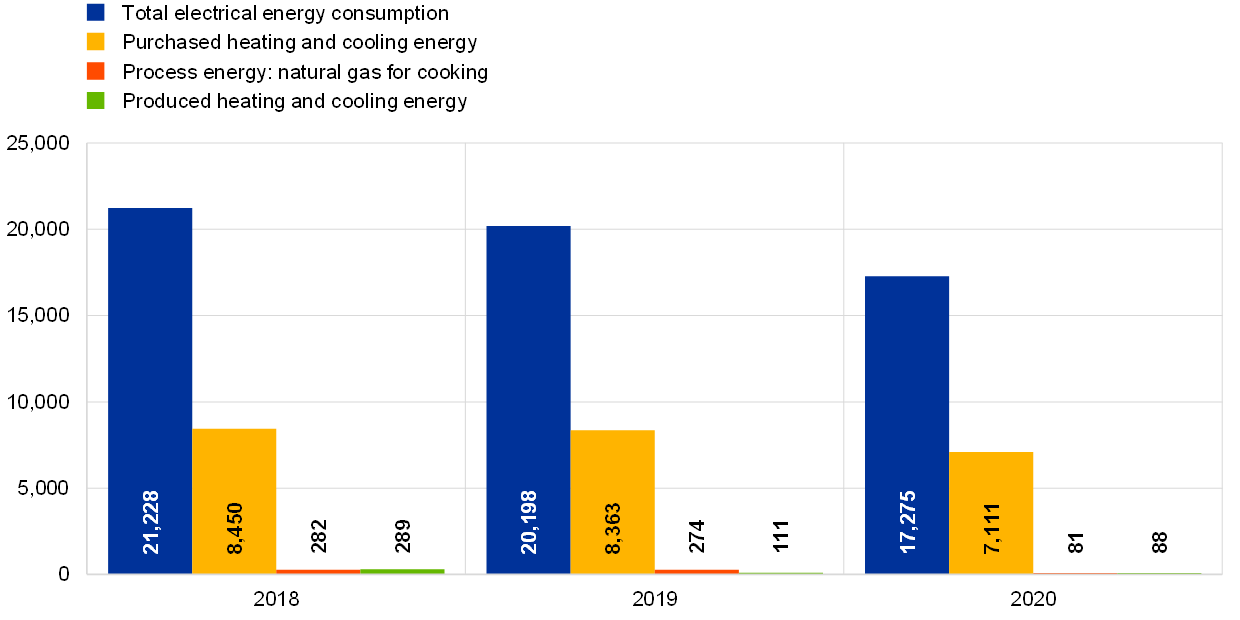
Source: ECB.
Chart 1b
Energy consumption – city centre buildings
(MWh)
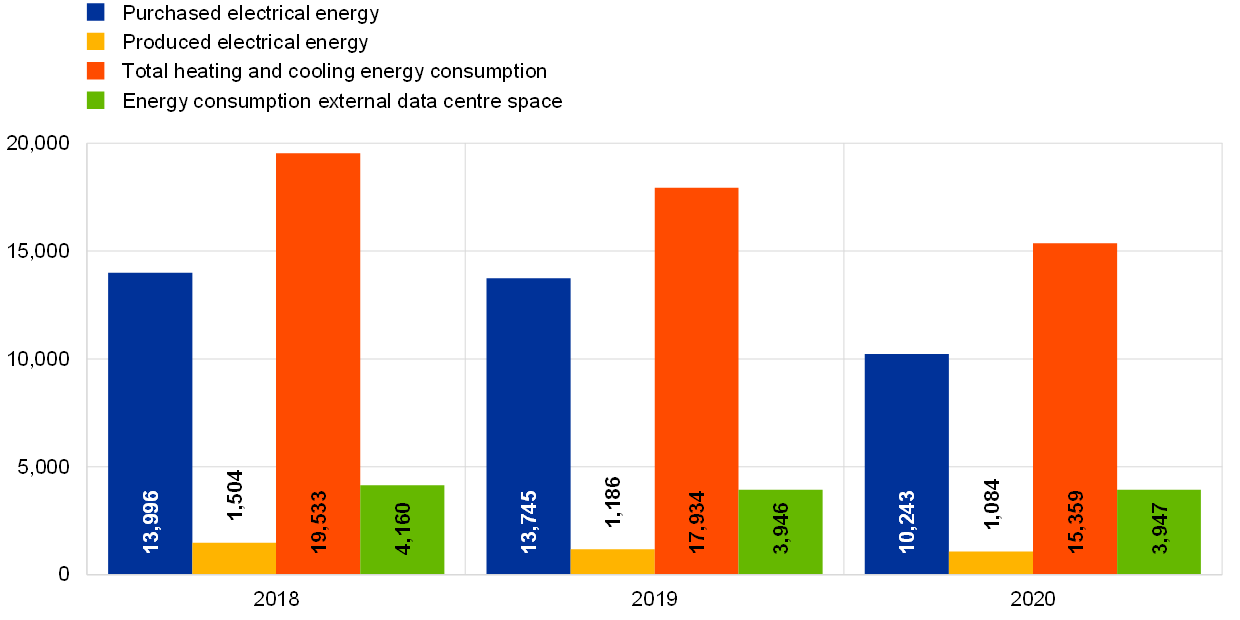
Source: ECB.
3.3 Material efficiency



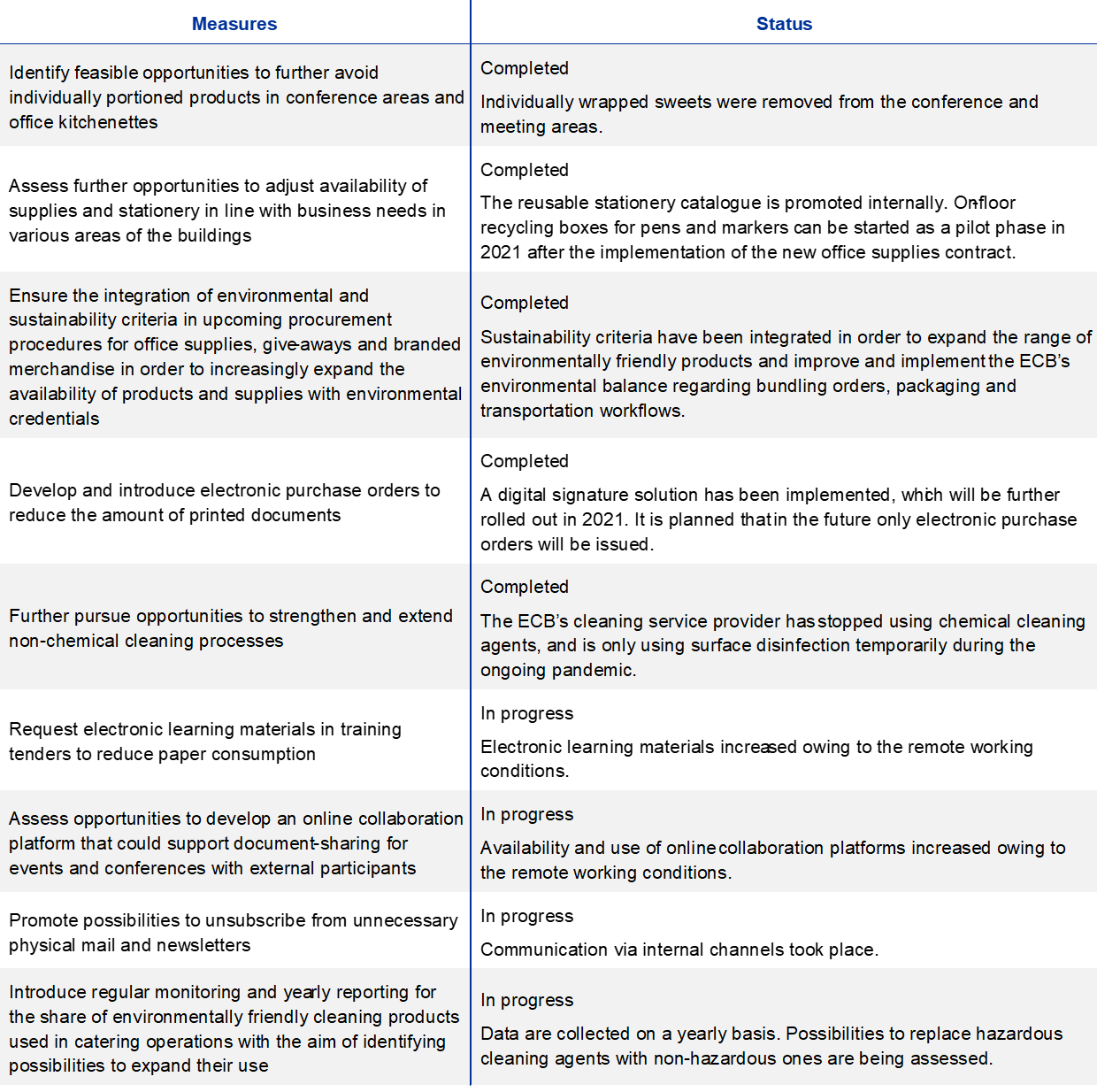
3.3.1 Publications

Paper consumption for official publication is characterised by strong fluctuations related to the number of external communication campaigns. In 2019 there was a rebound in paper consumption for official publications owing to the introduction of the new €100 and €200 banknotes and the publication of related information material. By contrast, in 2020 paper consumption for official publications at the ECB dropped significantly to 0.53 tonnes.
Chart 2
Paper consumption for official publications
(tonnes)

Source: ECB.
3.3.2 Office paper

The default remote working conditions in 2020 further supported the digitalisation of processes across the ECB. Office paper consumption has been steadily declining since 2017, but fell by 84.6% in 2020 compared with the previous year. While this fall was largely related to the limited on-site presence in 2020, various measures have been implemented that are likely to sustain reduced paper consumption beyond the COVID-19 pandemic. For example, the ECB has implemented e-tendering and electronic signatures as well as further digital collaboration tools that support paperless collaboration. Moreover, the ECB has reduced the environmental footprint of its paper consumption by using recycled paper, which now accounts for 98.3% of all the paper it consumes.
The consumption of other paper products, such as letterheads, calendars and notepads, is to be considered in addition to office paper and is reported for the first time this year. Other paper products accounted for 25.5% of total office paper in 2020, and their consumption decreased by 52.8% compared with the previous year.
Efforts to reduce the number of single office printers continued in 2020, with various communications having been launched at senior management and staff level. Significant reductions were realised and the number of printers was reduced to 0.6 individual printers per ten workplaces. Although the objective of 0.5 printers per ten workplaces by 2020 was narrowly missed, the ECB remains committed to phasing out its individual printers, except for a limited and justified number of printers that are required for business purposes.
For additional information, see Chapter – 3.8 Green public procurement.
Chart 3
Office paper consumption
(thousands of sheets (A4 equivalent))

Source: ECB.
Notes: Consumption of other paper products, such as letterheads, calendars and notepads, is reported the first time. The paper consumption in 2019 has been adjusted on the basis of an improvement in the monitoring and reporting process from 8,464 to 16,538 thousand sheets (A4 equivalent).
Prior to the COVID-19 pandemic, various measures were successfully introduced to reduce individual packaging in the catering areas. These achievements have been challenged by strict hygiene requirements resulting from the COVID-19 pandemic. Specifically, disposable items, such as take-away containers, were reintroduced in the catering and service areas. To reduce the environmental impact, biodegradable packaging made from sugar cane and other natural materials was introduced. Moreover, the reusable coffee cup scheme that was introduced in 2019 continued to be in place and the deposit system was extended to bowls, cutlery and plates. It is also planned to again limit the use of disposables and packaging insofar as possible as soon as the hygiene requirements related to the COVID-19 pandemic are lifted.
3.3.3 Cleaning agents

The ECB continued to use 99.9% biodegradable, microbiological cleaning agents in 2020. Even though hand sanitiser and surface disinfectants needed to be introduced for hygiene purposes, the overall use of cleaning agents in the main building and in the city centre buildings decreased by 36.3% and by 33.8%, respectively, in 2020 compared to the previous year. This decrease stems from a reduction in facility cleaning needs and the considerably reduced catering services.
Chart 4
Cleaning agents consumption
(tonnes)

Source: ECB.
Note: The amount of cleaning agents consumed in the main building in 2019 has been adjusted on the basis of an improvement in the monitoring and reporting process from 9.89 tonnes to 8.39 tonnes.
3.3.4 Office supplies

Environmental labels are included in the ECB’s stationery catalogue with the aim of supporting staff in identifying eco-friendly stationery and increasing its use. The ECB also continuously increases the share of sustainable office supplies in its stationery catalogue, which reached 38% in 2020.
In addition, the ECB's internal catalogue for reusable stationery has contributed to a decline in new external orders and ECB staff have been advised on how to limit the environmental impact of stationery and office supply orders.
Decommissioned IT equipment, such as laptops, monitors, phones and printers, is donated by the ECB to a range of charitable organisations.
3.3.5 Chemicals for water treatment and cooling agents

Compared to the year before, the use of chemicals for water treatment in the main building fell by 38.2% in 2020 owing to the reduction in fresh water use in the offices. In an effort to reduce the use of chemicals, a small share of bio-organisms was introduced in the water treatment process.
In the city centre premises, the use of chemicals for water treatment decreased by 63.5% compared to the previous year. One reason for this large decline was the use of remaining stocks from 2019 in the Japan Center, which were included in the 2019 figures.
Regular inspections and maintenance of cooling installations at the ECB premises were conducted and no cooling agent leakages occurred in 2020. Furthermore, lava grit was used on outdoor walkways at the ECB’s premises during the winter to reduce the use of salt.
Chart 5
Chemicals used for water treatment
(tonnes)
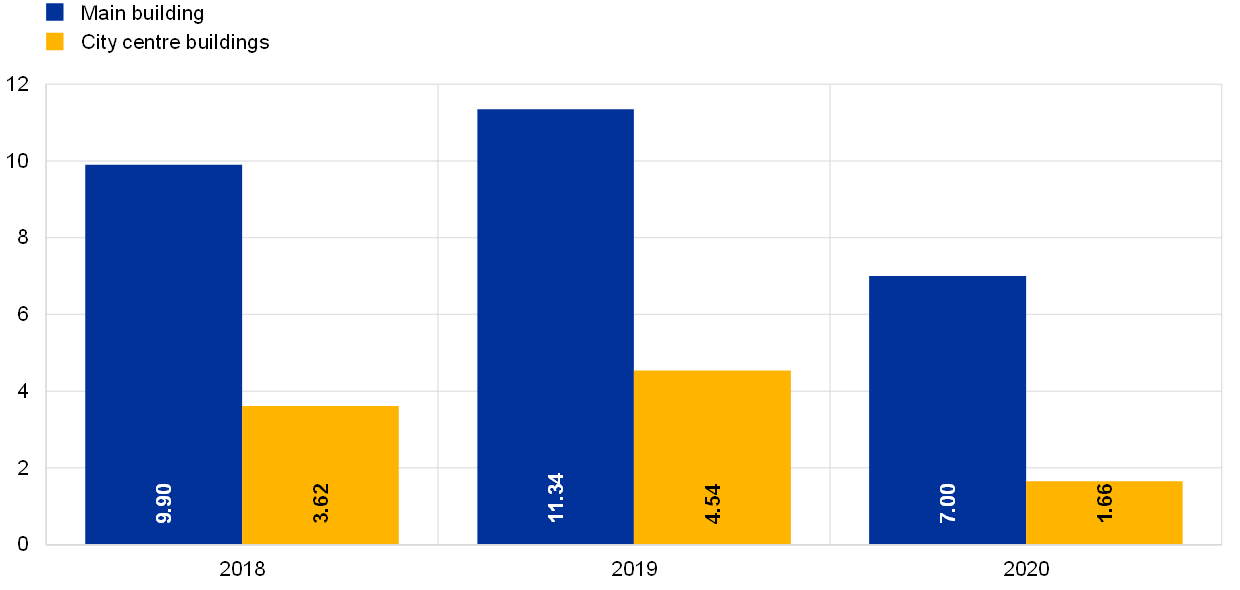
Source: ECB.
Chart 6
Cooling agent losses
(kilograms)
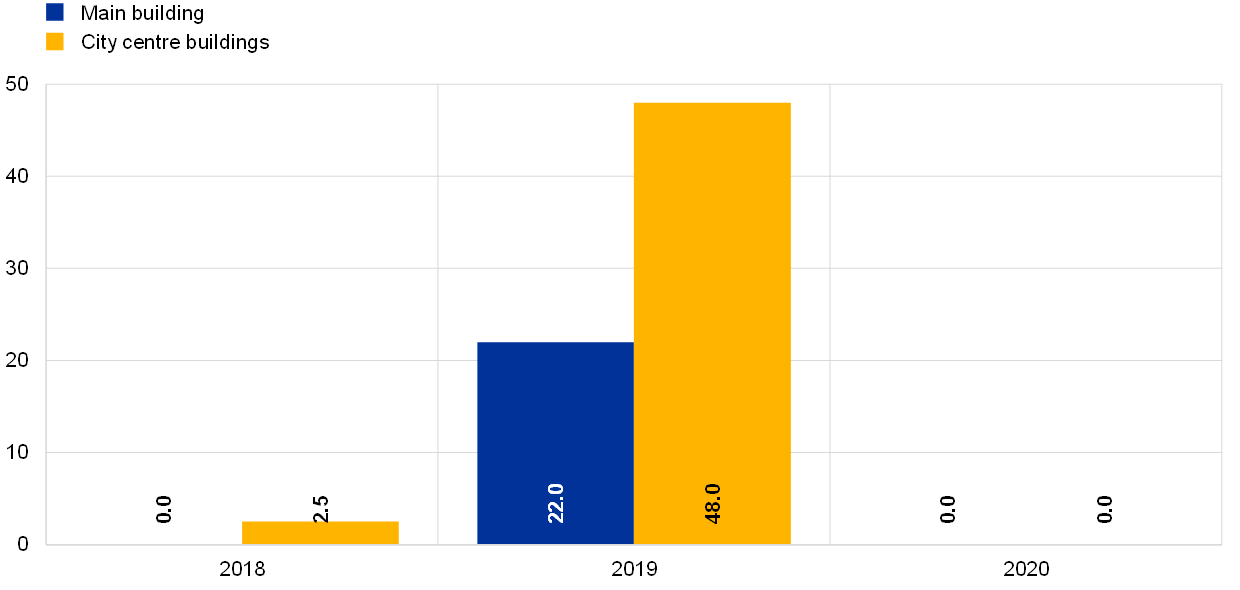
Source: ECB.
3.4 Water and waste water

The ECB’s water consumption comprises technical water used for building climate control, and non-technical water used in sanitary facilities, kitchenettes and canteens. At the main building, non-technical water also covers water used for irrigating the green areas. This difference needs to be considered when comparing water consumption of the main building and the city centre premises.
Owing to the low building occupancy rate, water consumption dropped considerably at the ECB’s premises. Nevertheless, regular flushing cycles of water pipes were conducted to meet hygiene regulations.

At the main building, fresh water consumption decreased by 22.1% in 2020 compared to the previous year. This comprised a 39.5% decline in technical water consumption and a 20.1% decline in non-technical water consumption. A noticeable amount of the non-technical water was used for the maintenance of the ECB’s green areas. The collection of rainwater from the roof of the Grossmarkthalle increased considerably in 2020 and was utilised for irrigation and sanitary facilities. In a further effort to reduce the consumption of water for irrigation, watering bags were introduced for all the trees. This allowed watering of the green areas to be reduced without harming the trees, even during very dry summers.

At the city centre premises, water consumption decreased by 36.6% compared to 2019. Technical water consumption decreased by 28.4% and non-technical water consumption by 39.8%.

Chart 7a
Water consumption – main building
(m³)
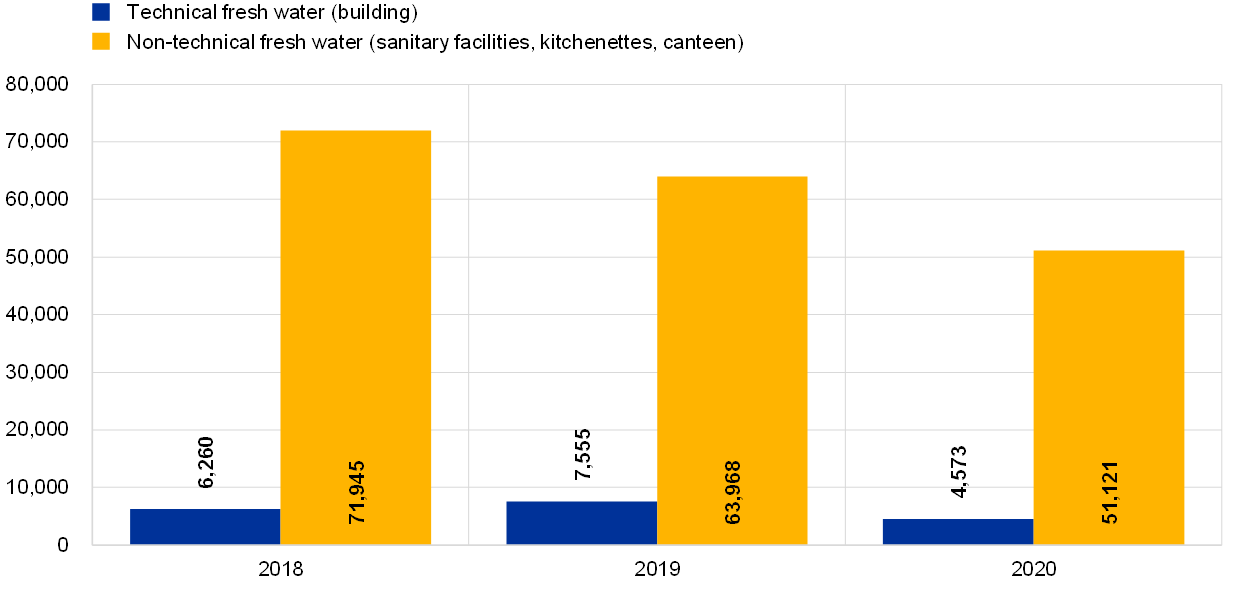
Source: ECB.
Chart 7b
Water consumption – city centre buildings
(m³)

Source: ECB.
3.5 Waste and recycling





Avoiding and reducing waste and increasing recycling rates play an important role at the ECB. Therefore, the ECB is pursuing its environmental objective of reducing its residual waste by 5% per workplace by 2023 and is taking various measures, both in terms of raising staff awareness and in terms of improving its waste infrastructure. The waste separation system in the kitchenettes was streamlined across all buildings, accompanied by the launch of new waste labelling and informative videos. Separate collection of coffee grounds was introduced and is planned to be extended to all ECB premises.
The hygiene measures related to the COVID-19 pandemic generated additional waste, such as packaging waste and personal protective equipment (PPE) waste, including used gloves and masks. However, owing to the low building occupancy, the total amount of waste declined by 46.2% in 2020.
Non-hazardous waste accounted for 96% of the ECB’s total waste in 2020. This waste includes materials such as plastic packaging, organic waste, residual waste, paper and cardboard, and confidential paper waste. The remaining 4% of the ECB’s total waste consisted of 19.9 tonnes of hazardous waste, 18.9 tonnes of which were electronic waste and 1 tonne of which consisted primarily of batteries and lighting. IT waste increased from 4.2 tonnes in 2019 to 18.0 tonnes in 2020 as a large amount of stored IT hardware was disposed of and some IT assets were decommissioned at the end of their lifecycle.

The total amount of waste at the main building decreased by 48.9% in 2020 compared to the previous year. Nevertheless, paper and cardboard waste resulting from deliveries of IT devices in cardboard boxes and the fitting of the main building kitchenettes with new waste bins resulted in a smaller decrease in this type of waste than in other waste fractions.

The total amount of generated waste at the city centre premises declined by 42.3% in 2020 compared to the previous year. Nearly all waste fractions decreased in comparison to 2019, except for packaging waste. However, the indicated packaging waste amounts are partially based on estimations and most likely do not represent actual generated waste. In the Japan Center, relatively large amounts of paper and cardboard and packaging waste were generated, which can partly be traced back to the refitting of the staff restaurant and coffee shop areas.
Chart 8a
Waste and recycling – main building
(tonnes)

Source: ECB.
Note: The amount of organic waste in 2019 has been adjusted on the basis of an improvement in the monitoring and reporting process from 205.3 tonnes to 225.4 tonnes.
Chart 8b
Waste and recycling – city centre buildings
(tonnes)
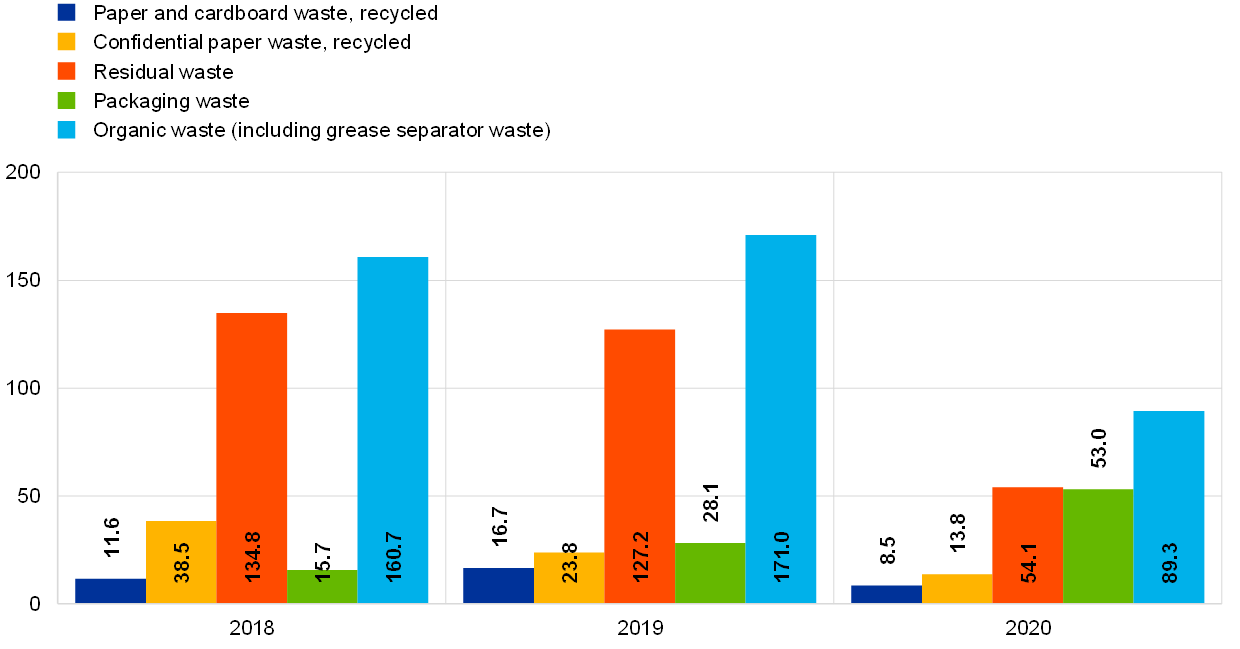
Source: ECB.
3.6 Biodiversity






Photographer and copyright:
Holmer Drews
In 2020 three wooden beehives were placed in the grounds of the main building as a further contribution to fostering biodiversity. The beehives were purchased from a social business employing people with disabilities. The hives are located in a meadow area with regional wildflowers that provide an ideal food base for the bees, while the nearby river supplies the bees with water. A beekeeper comes on site regularly to ensure that the bee population is thriving. In 2020 the first batch of honey from the “ECBees” was harvested. A large insect hotel for wild bees was also set up in the grounds of the main building as an addition to the wild insect hotels and the bird and bat houses that were already in place in the grounds of the main building.
Owing to the COVID-19 pandemic, opportunities to implement further activities on site, such as the urban gardening projects proposed by staff, were limited. However, in the autumn of 2020 an online workshop on how to foster biodiversity at home was offered as part of the regular Environmental Representatives workshops.
3.7 Banknotes

As part of the Eurosystem strategy on cash, the ECB endeavours to keep banknotes safe and sustainable. The ultimate aim is to ensure that euro banknotes and their production processes become more sustainable and more environmentally friendly.
The ECB has the exclusive right to authorise the issuance of banknotes within the euro area. Each national central bank (NCB) is responsible for a proportion of the total annual production in one or more denominations. At the end of 2020 there were 26.5 billion euro banknotes in circulation.
The ECB promotes good environmental management and seeks to avoid any risk to the health and safety of the general public and the workers involved in the production and circulation of euro banknotes. A manufacturer producing euro banknotes must first provide the ECB with copies of its ISO 9001, ISO 14001 and ISO 45001 certificates to show that it conforms to the standards applicable to the relevant manufacturing site. The ECB’s Directorate Banknotes monitors and regulates banknote production within the euro area, including the assessment of compliance with the ISO 14001 standard and the environmental impact of the production processes of the euro banknotes and their main raw materials.
The ECB and the Eurosystem NCBs are implementing policies to minimise the environmental impact of the production of euro banknotes. For example, in 2020 two-thirds of the approximately 7,500 tonnes of cotton fibres (the main raw material) used to produce banknote paper was certified as originating from an environmentally and socially sustainable source. The ECB is strongly committed to increasing the amount of sustainable cotton in euro banknote paper to 100%.
A series of research and development projects are ongoing to improve the environmental sustainability of current and future banknotes by increasing their circulation lifetime, reducing both the impact of the raw materials and the end-of-life impact of the banknotes. The ECB is continuing to engage with all stakeholders in the supply chain to identify potential improvements and solutions regarding environmental sustainability in euro banknote manufacturing as well as in the entire life cycle of the banknotes.
Detailed information on the environmental impact of euro banknotes is provided on the ECB’s website in the section on “The €uro”.
3.8 Green public procurement



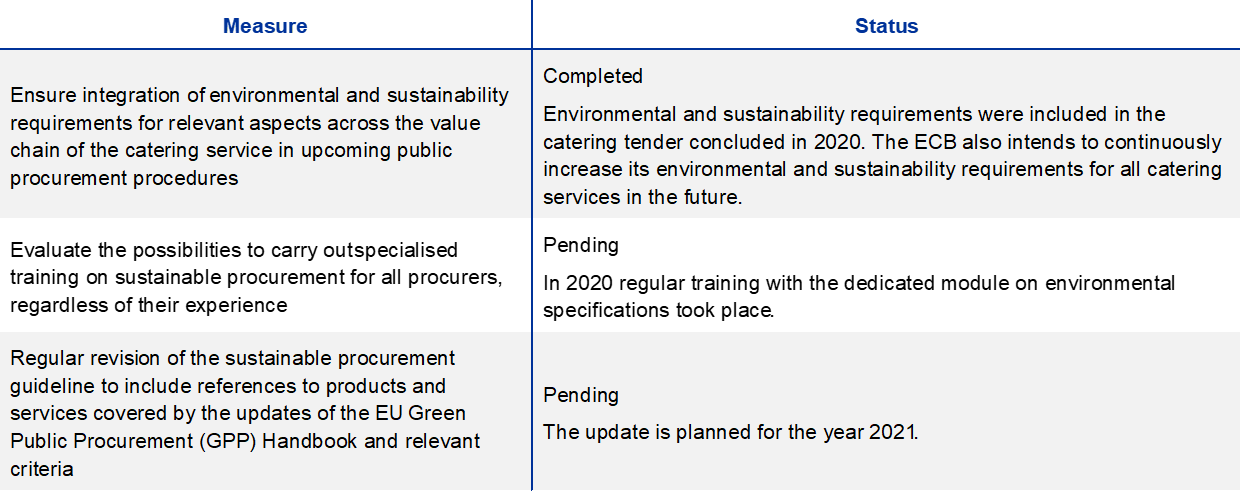

Green public procurement (GPP) is an important tool to reduce environmental impacts along the ECB’s value chain.
Procurement experts and teams across the ECB have several means at their disposal to include environmental considerations in procurements, the most relevant being the green award and selection criteria included in the sustainable procurement guideline and training on how to integrate environmentally friendly tender specifications.[1] Furthermore, the ECB has joined other institutions and bodies of the European Union in a joint tender for an interinstitutional GPP Helpdesk and, as of 2021, it will have access to the helpdesk services, good practices and knowledge database.
In 2020 the ECB continued its efforts to reduce paper consumption in procurement and contract management processes: invoices were submitted and processed electronically, and all public tenders were carried out via the e-tendering platform, which has been rolled out to all procurements. Owing to the increase in teleworking, the ECB adopted an interim signature process to remotely sign contracts, purchase orders and outcome letters in procurements. E-signatures have since been rolled out to facilitate the signature process, and they are also planned to be used beyond the pandemic.
3.9 Travel activities

2020 saw profound changes in the way organisations meet and perform their duties, with tough restrictions on business travel and commuting across the globe for most of the year. The ECB, like many other organisations, had to adapt and find new ways to perform its tasks and fulfil its mandate by shifting to online collaboration, while still fostering the exchange of information and collaboration with NCBs, national competent authorities and other stakeholders.
Business travel represented the largest share of the ECB’s carbon footprint between 2015 and 2019, accounting for 34.1% of the ECB’s total reported carbon emissions in 2019. In 2020 emissions from business travel decreased by 89.4% compared with the year before. However, the abrupt interruption of most travel-based activities in 2020 provided an opportunity to increase the availability and acceptance of online collaboration and videoconferencing tools both inside and outside the organisation, thereby also raising the possibility of drastically reducing travel and commuting in the future.
The ECB recognises that the decrease in commuting and on-site emissions related to its teleworking regime, which was in place for most of 2020, was partly counterbalanced by the increase in emissions related to video-conferencing and the relocation of environmental impacts to employees’ homes, where the ECB has limited scope to monitor and influence emissions. These relocated environmental impacts will be taken into account in the carbon footprint assessment exercise that the ECB started in 2020 and which is planned to be implemented as of 2021. In 2020 estimated CO2 emissions from electricity consumption by ECB staff working remotely amounted to approximately 65 tonnes, which, if added to the ECB’s reported carbon footprint, would correspond to 1.1% of the total 2020 carbon footprint. In 2021 the ECB plans to improve its estimation by conducting a revised staff commuting survey to better capture the additional environmental impact of the extended teleworking regime.
To improve its monitoring and control of business travel-related emissions once restrictions are reduced, the ECB finalised several data analytics projects to refine the collection and monitoring of data, raise awareness of the environmental impact of business travel and identify further opportunities to reduce travel and event-related emissions. These projects include a tool to help meeting and event organisers to estimate the emissions avoided by implementing online meetings instead of face-to-face meetings.
3.10 Communication, engagement and awareness raising




Raising staff awareness remained a central element of the ECB’s environmental management system in 2020. The ECB actively organised various awareness-raising online events, which comprised information sessions, expert talks, workshops and competitions. The events targeted internal and external stakeholders, such as staff and contractors, and some were joined by staff from other European institutions.
As in previous years, the ECB took part in the WWF Earth Hour in March 2020 by switching off all non-essential lights at its premises to display its commitment to climate protection. On the occasion of the global Earth Overshoot Day in August, the ECB raised awareness among staff and stakeholders about ecological resource depletion. The ECB also took the opportunity of the European Mobility Week in September to inform staff about sustainable means of transport and current and future changes in mobility in the context of the COVID-19 pandemic. In addition, the ECB participated for the second time in the European Week for Waste Reduction in November, during which the Green ECB team organised an expert talk on the impact of the COVID-19 pandemic on sustainable waste management, two workshops on digital waste and plastic pollution, and a waste quiz.
Awareness-raising activities initiated by the Green ECB team are strongly supported by the Environmental Representatives who play a key role in promoting eco-friendly behaviour across the organisation. Apart from supporting the Green ECB team, they also initiate their own awareness-raising activities within their business areas by fostering horizontal communication on environmental topics, holding presentations and sending out newsletters to their colleagues.
The ECB also regularly communicates about its environmental initiatives via its social media channels. To mark the 25th anniversary of EMAS and the publication of its environmental statement, the ECB raised two EMAS flags in the city centre in September 2020.
The ECB is also involved in interinstitutional networks to exchange information and best environmental management practices with NCBs and other European institutions. These include the Interinstitutional Environmental Management Group (GIME), which comprises institutions and bodies of the European Union, and the Environmental Network of Central Banks (ENCB), which connects NCBs for the exchange of information and best practices.
Read more about EMAS in the European Institutions.
4 CO2 emissions reduction



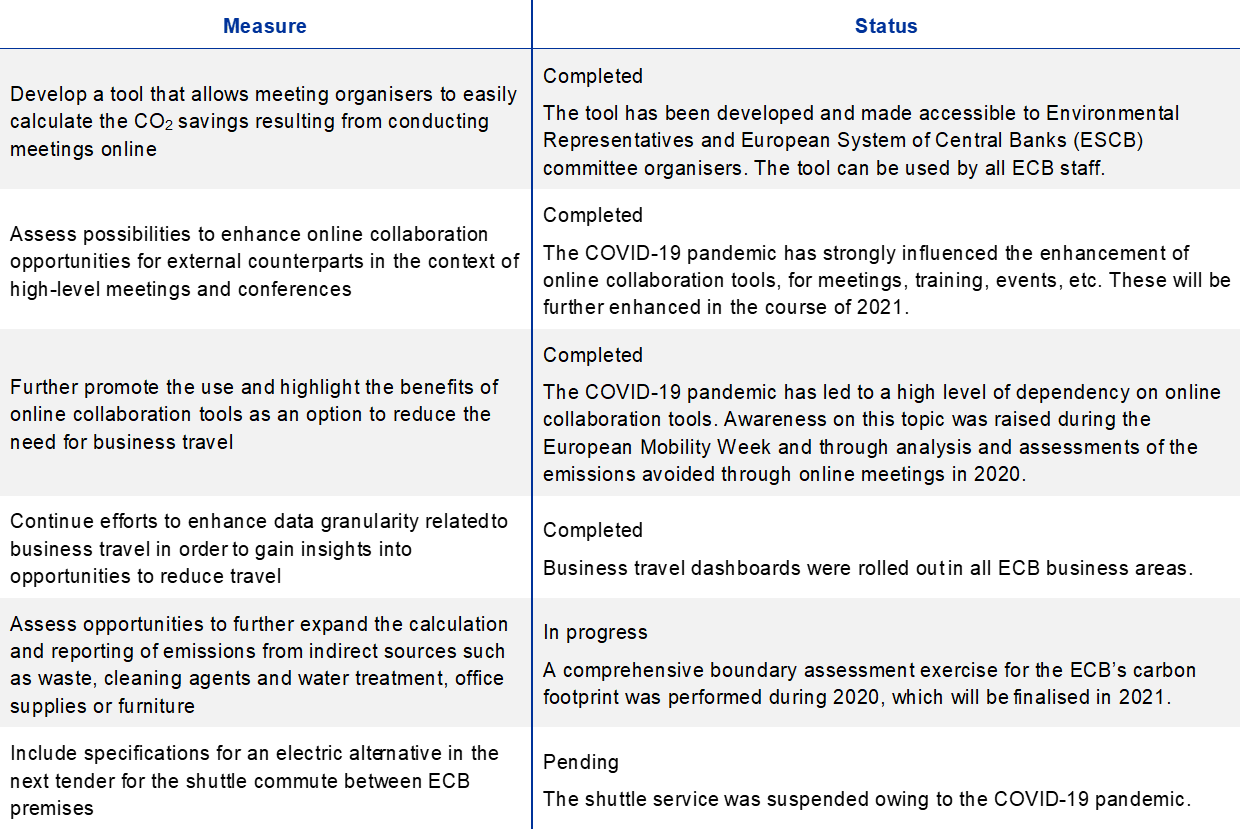

Each year the ECB’s CO2 emissions are calculated on the basis of collected activity data which are compiled in an environmental inventory. The allocation of direct and indirect emissions to Scopes 1, 2 and 3 is in line with the Greenhouse Gas Protocol.[2]

Conversion factors used in the calculation of CO2 emissions are updated annually. Updates of emission factors in 2020 are presented in Chapter 5 – Technical information.
Chart 9 shows a breakdown of the ECB’s CO2 emissions by the different scopes of the Greenhouse Gas Protocol.
Chart 9
Total CO2 emissions: Scopes 1, 2 and 3
(tonnes CO2 equivalent)

Source: ECB.
Notes: Scope 1 and 3 values for 2018 and 2019 have been adjusted to improve alignment with the reporting guidelines of the Greenhouse Gas Protocol. Scope 1 values were changed from 2,800.0 tonnes to 3,103.1 tonnes in 2018 and from 2,872.4 tonnes to 3,111.4 tonnes in 2019. Scope 3 values were changed from 5,463.4 tonnes to 5,471.7 tonnes in 2018 and from 5,245.1 tonnes to 5,250.6 tonnes in 2019.

In comparison to 2019, total reported CO2 emissions from the ECB’s activities decreased by 45.2% in 2020. This reduction shows the exceptional impact of the COVID-19 pandemic on the ECB’s carbon footprint. This development contributed to reflections on how to sustainably reduce emissions in the long run and the opportunities to further support European and global climate goals.
In 2019 Scope 1 and 2 emissions accounted for approximately 50% of the ECB’s total reported CO2 emissions. In 2020, this share grew considerably to 78.4%, mostly as a result of decreasing Scope 3 emissions. Emissions from Scopes 1 and 2 are directly related to the operation of the ECB premises. They mainly cover the consumption of heating and cooling energy as well as fuel consumption. The ECB does not report emissions related to electricity consumption in Scope 2, as 100% of the electricity has been purchased from renewable sources since 2016. However, increasing energy efficiency and reducing energy consumption remain high priorities for the ECB’s environmental management.
Chart 10
CO2 emissions: Scopes 1 and 2
(tonnes CO2 equivalent)
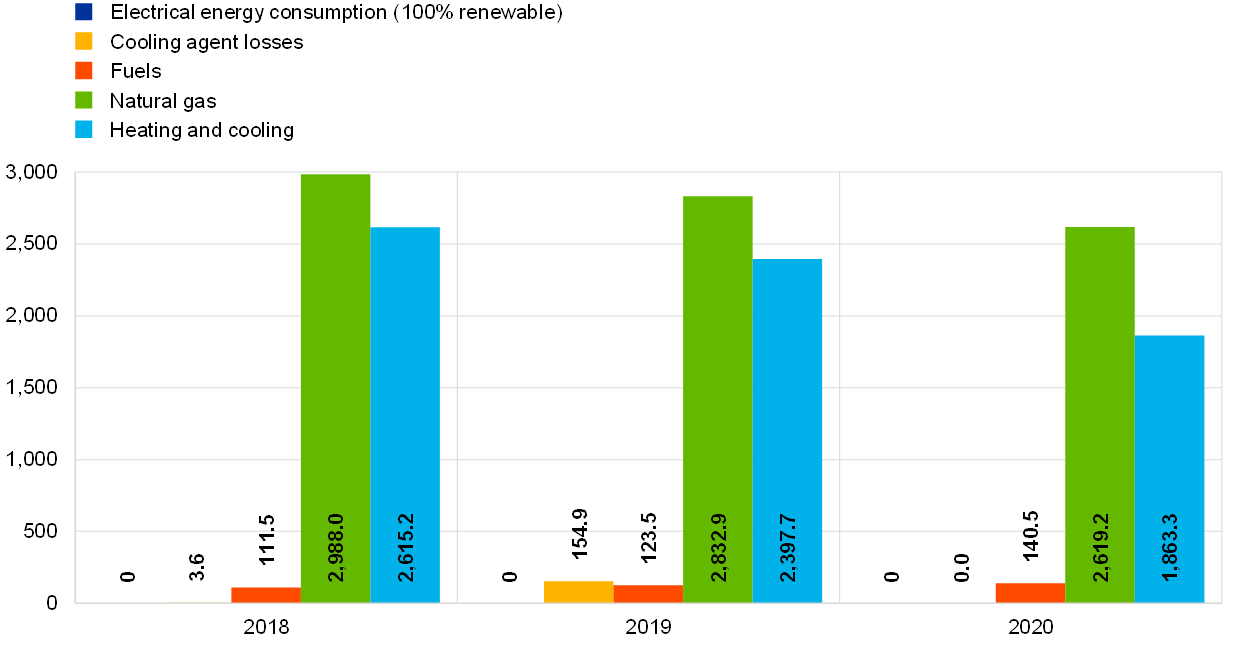
Source: ECB.
Notes: Emissions from natural gas for 2018 and 2019 have been adjusted on the basis of an improvement in the monitoring and reporting process from 2,684.9 tonnes to 2,988.0 tonnes in 2018 and from 2,593.9 tonnes to 2,832.9 tonnes in 2019.
The ECB’s Scope 3 emissions cover emissions related to business travel, commuting and paper consumption (related to office activities and for external communication). In 2020 Scope 3 emissions accounted for only 21.6% of the ECB’s total reported CO2 emissions. This was a departure from previous years where Scope 3 emissions made up around 50% of the ECB’s carbon footprint.

This shift in the relative significance of Scope 3 emissions has been driven mostly by the restrictions on business travel, which resulted in meetings and conferences being moved to an online format. Compared with 2019, CO2 emissions from business travel decreased by 89.4%. The new way of working strongly accelerated the introduction of additional online communication and collaboration tools.

The strong decrease in Scope 3 emissions is also linked to the teleworking regime which has been in place since mid-March 2020 and which led to a 42.2% decrease in emissions from commuting compared to 2019. Information on teleworking days, distances travelled and means of transport were taken into account when estimating this share of emissions. Therefore, when interpreting this information, it needs to be borne in mind that the calculation of CO2 emissions is largely based on assumptions and is most likely overestimated.
The ECB regularly raises awareness among staff about sustainable means of transport, such as during its engagement in the European Mobility Week in September 2020. The ECB has also carried out projects to increase the availability of electric car charging stations and has improved facilities for cyclists.
Chart 11
CO2 emissions: Scope 3
(tonnes CO2 equivalent)
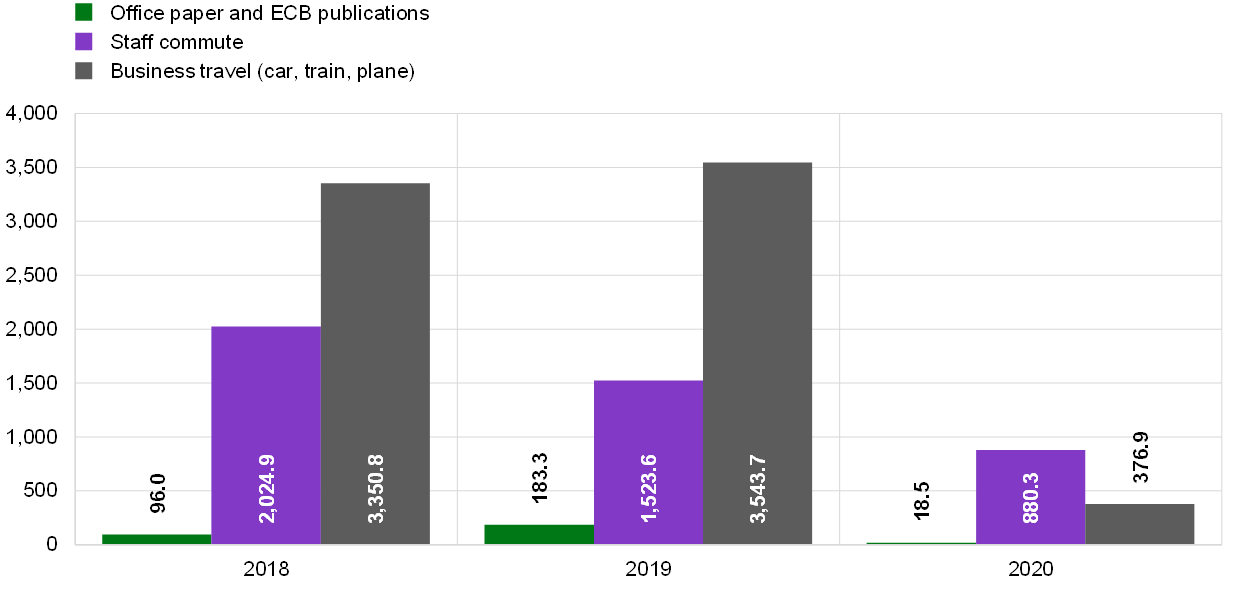
Source: ECB.
Notes: Emissions from office paper and ECB publications have been adjusted on the basis of an improvement in the monitoring and reporting process from 87.7 tonnes to 96.0 tonnes in 2018 and from 138.3 tonnes to 183.3 tonnes in 2019. Emissions from business travel have been adjusted from 3,583.2 tonnes to 3,543.7 tonnes in 2019.
Chart 12
Shares of CO2 emissions

Source: ECB.
The ECB is currently working on expanding the scope of its carbon footprint to account for further Scope 3 emissions along the ECB’s value chain as well as on setting new ambitious targets to contribute to climate change mitigation goals. While continuously working on implementing measures to reduce its environmental impact, the ECB plans to again offset its reported residual greenhouse gas (GHG) emissions by taking part in a joint public tender launched by the European Parliament in collaboration with other European institutions for the selection of suitable offsetting projects.
Apart from the already presented CO2 emissions, emitted amounts of sulphur dioxide (SO2), nitrogen oxides (NOx) and particulate matter (PM) are also assessed and reported. These emissions result from the ECB’s car fleet, test runs of emergency power units and natural gas consumption. The corresponding figures can be found in Chapter 5 – Technical information.
5 Technical information
Developments and measures regarding the ECB’s most important environmental aspects were illustrated in the previous chapters. This chapter focuses on presenting additional data concerning the ECB’s environmental performance in accordance with the EMAS Regulation (EMAS III)[3].
Workplace overview

Source: ECB.
Percentage differences between the CO2 emission conversion factors applied to calculate the emissions in 2019 and 2020 are provided in the following table. These differences are based on the most recent conversion factors of the respective sources.[4]
5.1 Conversion factor update
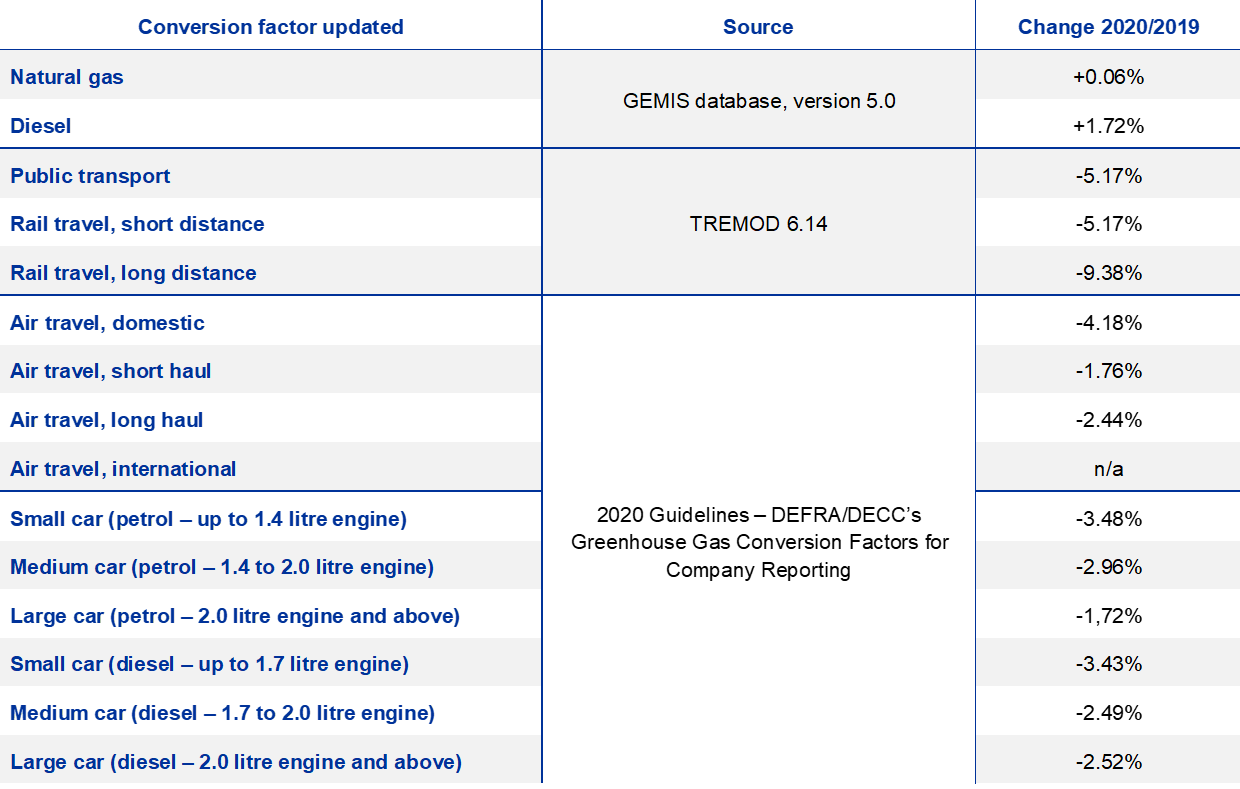
Note: The category “Air travel, international” was introduced in 2020 to further refine the calculation of business travel related emissions.
Other conversion factors

5.2 Environmental performance indicators (workplace indicators) 2018‑2020
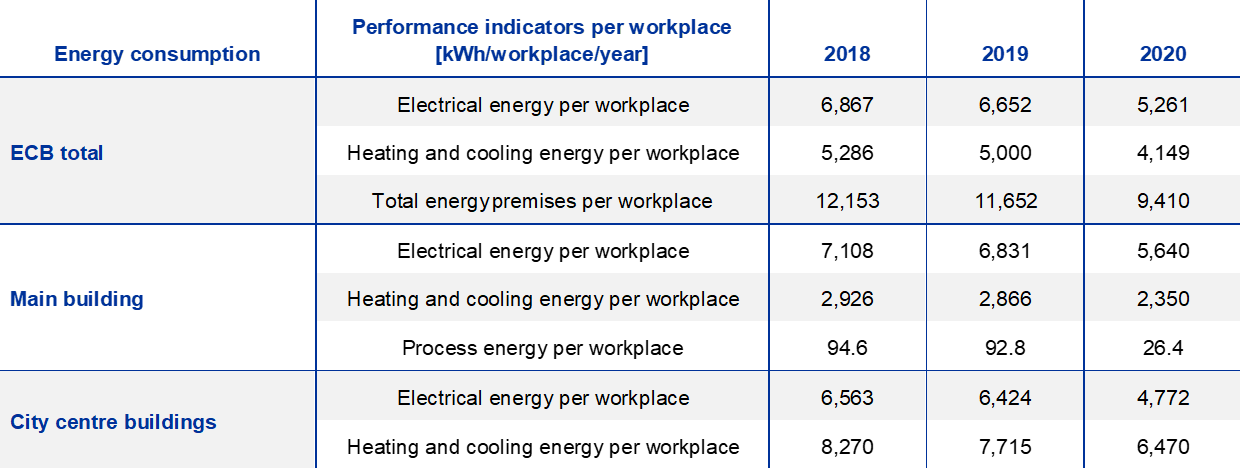

Notes: Consumption of other paper products such as letterheads, calendars and notepads, is included for the first time. The amount of paper consumption in 2019 has been adjusted on the basis of an improvement in the monitoring and reporting process. Office paper per workplace was adjusted from 3,679 sheets to 3,973 sheets of A4 equivalent per workplace in 2018 and from 1,603 sheets to 3.480 sheets of A4 equivalent per workplace in 2019.

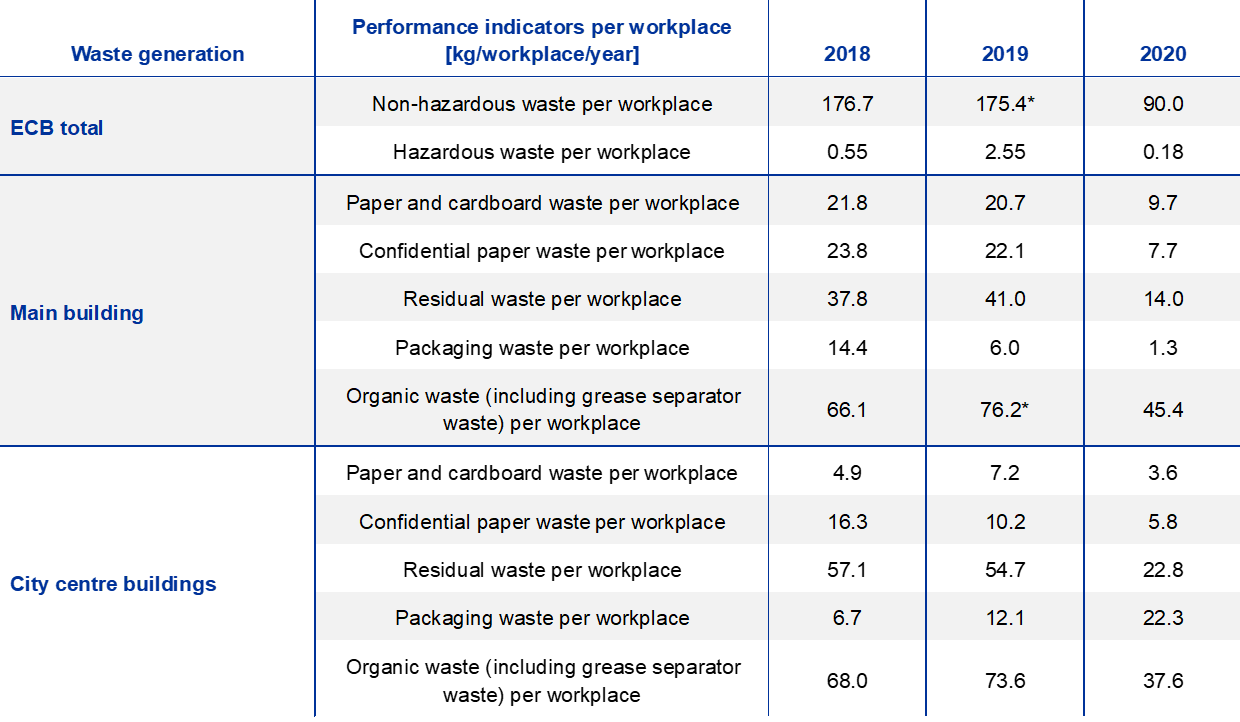
Notes: * The amounts of organic waste for 2019 have been adjusted on the basis of an improvement in the monitoring and reporting process. Amounts in the main building were adjusted from 69.4 kg to 76.2 kg per workplace in 2019. As a result, the total amount of non-hazardous waste per workplace was changed from 171.6 kg to 175.4 kg in 2019.
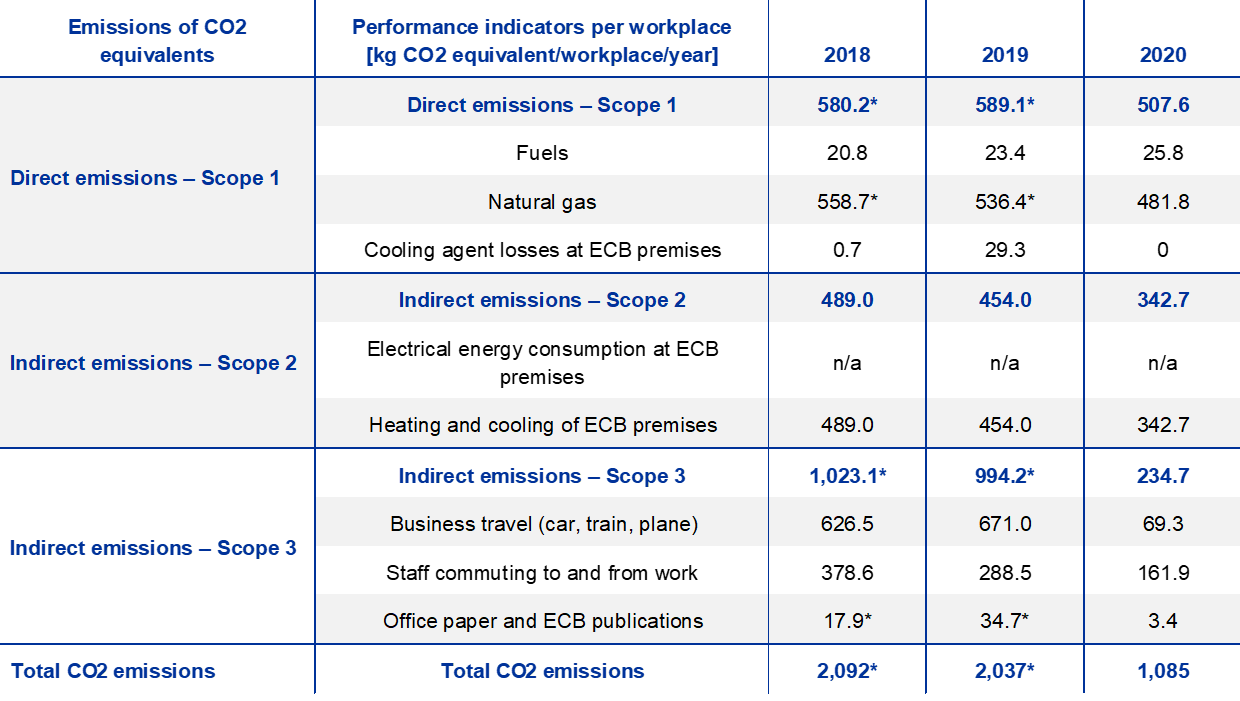
Notes: * Emissions from natural gas and from office paper and ECB publications for 2018 and 2019 and emissions from business travel for 2019 have been adjusted on the basis of an improvement in the monitoring and reporting process. Emissions from natural gas were changed from 502.0 kg to 558.7 kg per workplace in 2018 and from 491.2 kg to 536.4 kg per workplace in 2019. Emissions from office paper and ECB publications were changed from 16.4 kg to 17.9 kg per workplace in 2018 and from 26.2 kg to 34.7 kg per workplace in 2019. Emissions from business travel were changed from 678.5 kg to 671.0 kg per workplace in 2019. As a result, the emissions from Scope 1 were changed from 523.5 kg to 580.2 kg per workplace in 2018 and from 543.9 kg to 589.1 kg per workplace in 2019. Emissions from Scope 3 were changed from 1,021.5 kg to 1,023.1 kg per workplace in 2018 and from 993.1 kg to 994.2 kg per workplace in 2020. Total CO2 emissions were changed from 2,034 kg to 2,092 kg per workplace in 2018 and from 1,991 kg to 2,037 kg per workplace in 2019.



5.3 Compliance obligations

The environmental compliance obligations to be met by the ECB are defined in German and municipal regulations. All environmental obligations are summarised in a register which is reviewed and updated periodically by legal experts. Significant changes and required measures are monitored to ensure compliance with the environmental regulations. A significant part of the ECB’s compliance obligations relates to the operation and maintenance of the ECB’s buildings and contracted services, such as cleaning and catering. The ECB’s environmental compliance is assessed in the course of annual internal environmental checks. No discrepancies were detected in the latest assessments.
Relevant areas of environmental legislation and related facilities/activities
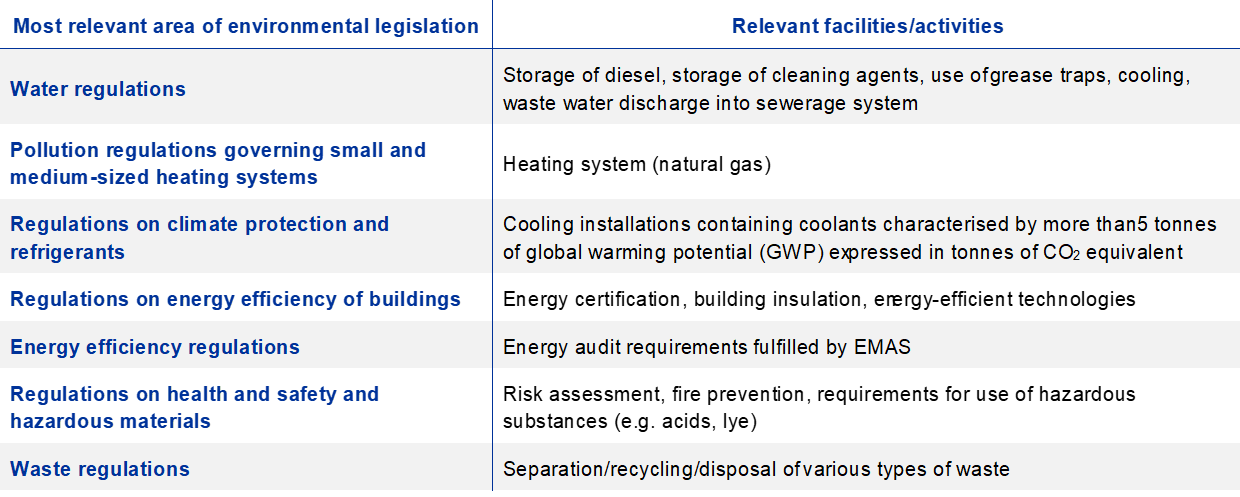
Apart from environmental legal obligations, the ECB has committed itself to further environmentally relevant obligations such as sustainable procurement guidelines and environmental business objectives. The ECB also aims to raise awareness of relevant environmental issues among staff by participating in a variety of communication campaigns. Accepting and addressing the challenges resulting from climate change, the ECB supports standard-setters, legislators and market participants in detecting climate change-related risks.
More information about climate change and the ECB can be found on the ECB’s website.
6 Environmental verifier’s declaration
Environmental verifier's declaration on verification and validation activities
The undersigned, BSI Group Deutschland GmbH, an environmental verification body with the registration number DE‑V‑0228, accredited and licensed for the areas of “Financial service activities, except insurance and pension funding” (NACE Rev, 2: NACE 64), confirms that it has verified whether the environmental declaration of the European Central Bank (ECB), at its sites at Sonnemannstrasse 20, 60314 Frankfurt am Main, Germany (main building) and at Kaiserstrasse 29, 60311 Frankfurt am Main, Germany and Taunustor 2, 60311 Frankfurt am Main, Germany (city centre), with registration number D‑125‑00045, meets all the requirements of Regulation (EC) No 1221/2009 of 25 November 2009 as amended by Commission Regulations (EU) 2017/1505 of 28 August 2017 and 2018/2026 of 19 December 2018 of the European Parliament and of the Council, on the voluntary participation by organisations in a Community eco-management and audit scheme (EMAS).
The signature of this validation confirms that:
- the verification and validation has been carried out in full compliance with the requirements of Regulation (EC) No 1221/2009 as amended by Commission Regulation (EU) 2017/1505 and 2018/2026;
- the result of the verification and validation confirms that there is no evidence of non-compliance with applicable environmental legislation;
- the data and information in the environmental statement give a reliable, credible and truthful picture of all the organisation’s activities within the scope specified in the environmental statement.
This document is not equivalent to EMAS registration. EMAS registration can only be granted by a competent body under Regulation (EC) No 1221/2009.
This document shall not be used as a standalone piece of public communication.
Frankfurt am Main, 15 June 2021
Dr Rainer Feld
BSI Group Deutschland GmbH Umweltgutachterorganisation
Environmental verification body
(DE – V – 0228)

Disclaimer
This update of the ECB’s environmental statement provides information to the general public and other interested parties about the environmental performance and activities of the European Central Bank (ECB) in 2020. It can be found on the ECB’s website (see the page entitled “Environmental protection at the ECB”).The ECB was first validated under the EU Eco-Management and Audit Scheme (EMAS) in 2010. This environmental statement, which is the 12th to be produced within the EMAS validation cycle, is a follow-up to the consolidated environmental statement for 2019 and the update released in 2020. It is only complete when read together with those publications and contains updated data for the year 2020.This environmental statement was drafted in accordance with EMAS standards according to Regulation (EC) No 1221/2009 and its annexes.
© European Central Bank, 2021
Postal address 60640 Frankfurt am Main, Germany
Telephone +49 69 1344 0
Website www.ecb.europa.eu
All rights reserved. Reproduction for educational and non-commercial purposes is permitted provided that the source is acknowledged.
For specific terminology please refer to the ECB glossary (available in English only).
- In 2020 only 13 members of staff attended procurement training, which was fewer than in previous years, most likely owing to the COVID-19 pandemic.
- The Greenhouse Gas Protocol provides commonly used international accounting standards for reporting and managing greenhouse gas emissions.
- Regulation (EC) No 1221/2009 of the European Parliament and of the Council of 25 November 2009 on the voluntary participation by organisations in a Community eco-management and audit scheme (EMAS), repealing Regulation (EC) No 761/2001 and Commission Decisions 2001/681/EC and 2006/193/EC (OJ L 342, 22.12.2009, p. 1).
- Conversion factors are provided by: the UK Department for Environment, Food and Rural Affairs (DEFRA) and the UK Department of Energy and Climate Change (DECC); the German Environment Agency (Umweltbundesamt); the ECB’s energy supplier, Mainova; Deutsche Bahn; the Global Emissions Model for Integrated Systems (GEMIS); and the Institute for Energy and Environmental Research Heidelberg (ifeu).


